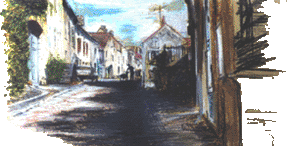A little history…
Flavigny as it appears if you approach from the “mountain.”

To walk through Flavigny is to take a step into the past. Parish records from 1784 tell us that the town once counted 1311 inhabitants; nowadays, there are scarecely 400, and in those houses which are empty or ruined, you can see just how quickly time does its work. In spite of this diminshment, the town is full of charm, a delightful place to live, to explore, to visit, perhaps even to stay a while. . .
. . . which is exactly what Julius Caesar, the town’s first famous visitor did. He settled in with his siege engines and his men in 52 BCE in order to put down once and for all the rebellion of Vercingetorix. Caesar built three camps and extensive fortifications in the form of circumvallations and contrevallations in order to besiege the Gaulish oppidum of Alésia, on the other side of the Ozerain.
During the Gallo-Roman period, the place called Flaviniacum began to make itself known. It was named for a land-owner named Flavinius, presumably the builder of a villa, an extensive agricultural and artisanal complex, a sort of Roman plantation; this community was complemented by a castrum, a military post of which no traces remain. These will have been the first permanent buildings on the site of the present village. In 719, the land came under the control of burgundian chieftains, and the Benedictine Abbey of St Pierre de Flavigny was founded.
During the Gallo-Roman period, the place called Flaviniacum began to make itself known. It was named for a land-owner named Flavinius, presumably the builder of a villa, an extensive agricultural and artisanal complex, a sort of Roman plantation; this community was complemented by a castrum, a military post of which no traces remain. These will have been the first permanent buildings on the site of the present village. In 719, the land came under the control of burgundian chieftains, and the Benedictine Abbey of St Pierre de Flavigny was founded.

The abbey flourished under the reign of Manasses. As at Luxueil, Agaune and St Benigne of Dijon, the monks performed continuous offices of praise. Charlemagne, who wrote to Manasses from Thionville, congratulated him on his accomplishments.